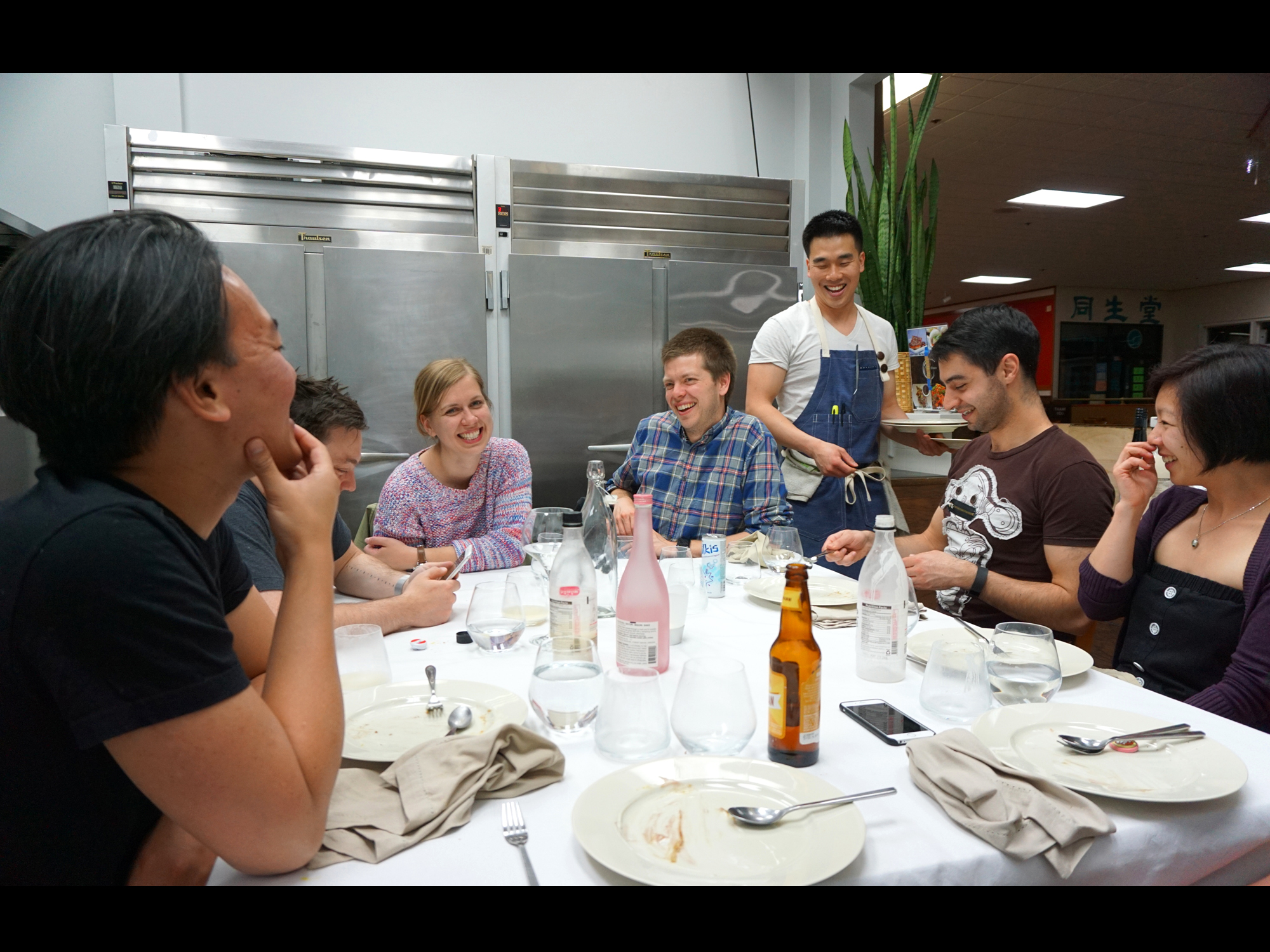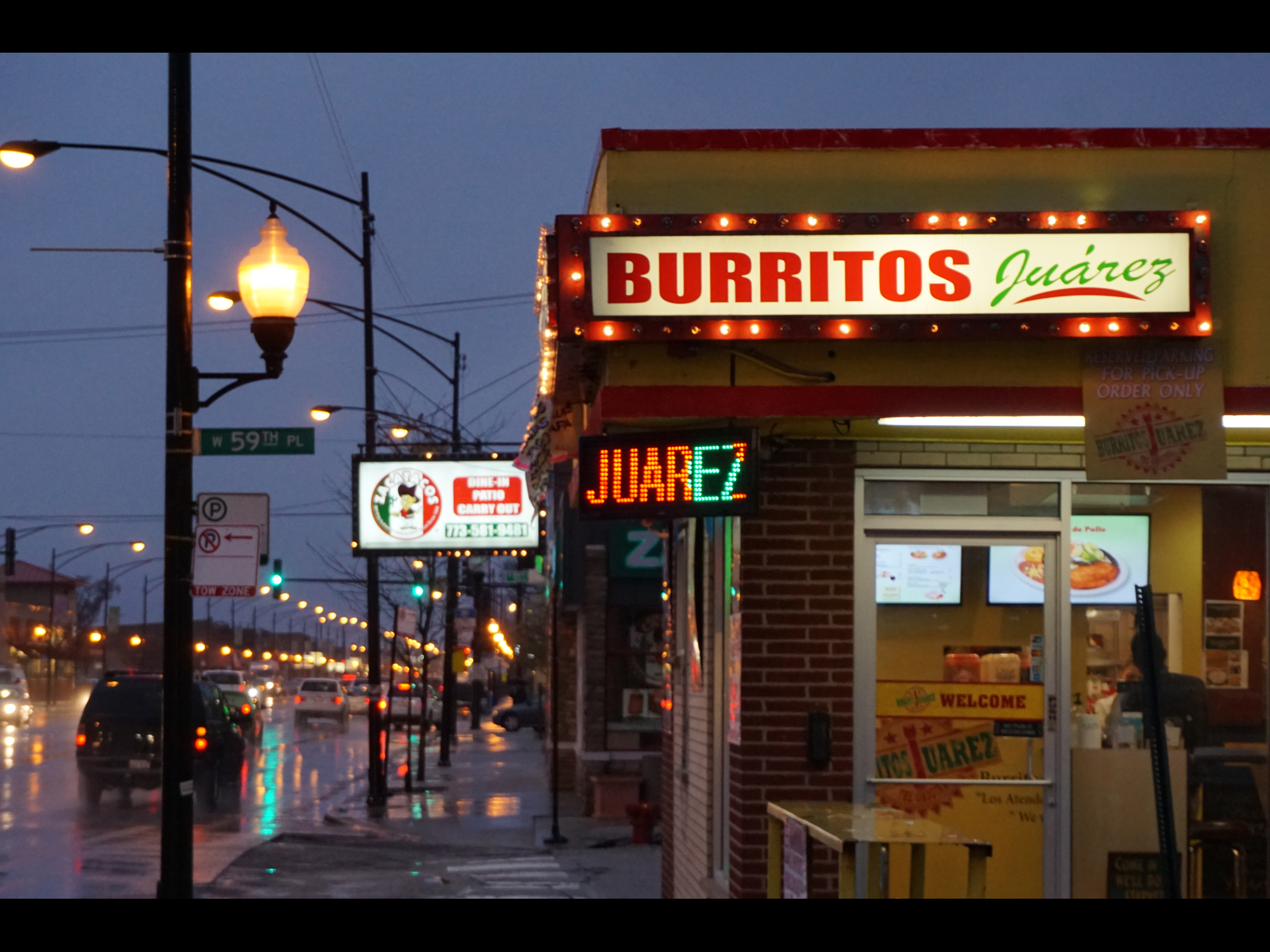IN THE LATE 19th CENTURY, THE MAXWELL STREET MARKET generated spontaneously on the near south side street of the same name. The Maxwell Street area was home to a number of newly arrived immigrants, Jews, Italians and others—and they were all eager to find a deal, making Maxwell Street a center for bargains, ripoffs and the discreet reclaiming of stolen property. And where there are people, there will be food—in those early years, deli food.
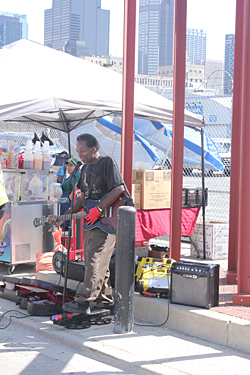
Chicago bluesman
Later came the Great Migration, and the neighborhood became more heavily African-American; the music brought from down South helped fuel the development of Chicago’s brand of electric blues, while barbecue found a place next to corned beef. This is the Maxwell Street depicted in 1980’s The Blues Brothers, with John Lee Hooker playing on the street in front of “Soul Food Cafe” (in real life, Nate’s Delicatessen).
After the year-round market was cleared off Maxwell in 1994 to make way for University Village, it drifted over to Canal, and by now the new vendors and the foodstuffs were increasingly Mexican—as I showed in this 2003 video tour. A few years after that, the market was moved once again. Now, every Sunday, from around 7am until around 3pm, the Maxwell Street Market sets up on Desplaines, between around Polk to around Taylor, the smell of masa and frying in lard predominating, with occasional notes of barbecue and Polish sausage.
The dimensions of the market change from month to month, sometimes even week to week; the market is constantly evolving. The mutable nature of the market makes creating a guide somewhat challenging, because Sunday-to-Sunday, vendors might be at different locations. To provide guidance that will be useful for at least a few years, I’ve focused on places that have been around for a while. Here are four guides to your Maxwell Street experience, each offering a different approach to tackling this unruly beast.
Guide 1: Must Try Market Chow
There are general areas where specific food vendors tend to locate, and I’ve indicated those areas in this guide, which moves from north (again, around Polk on Desplaines) to south (Taylor or beyond to Roosevelt). On that note, if you drive to the market, you’d do best to park a few blocks north of Roosevelt, around Polk; there’s metered parking, typically $4/hr. Also note that there’s a lot of street construction right now, so be prepared to improvise. (Alternately, take the Red Line, get off at Roosevelt, and walk west.)
In any case, these are the Maxwell Street Market All-Stars, the places that will make you wonder why you haven’t been going here your whole life.
Rubi’s
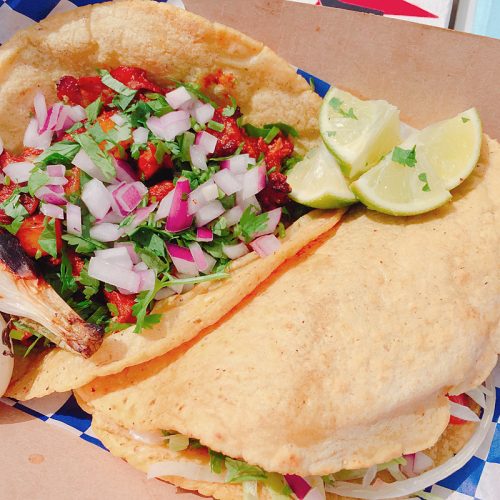
Taco al pastor from Rubi’s
Location: north end/west side
If you arrive at the market on the early side, you will probably want to go directly to Rubi’s, where they serve quesadillas and some of the most popular tacos at the market, filled with meat and/or cheese laid over freshly made tortillas and topped with a good amount of cilantro and onions. Despite what seems like a well-expedited serving line, a recent wait in a 10-person line took about 20 minutes. Around noon, the line had grown to over 60 or so people (!) Rubi’s serves a good taco, but it’s not worth an hour wait in line; if you get there before the crowds, then by all means, grab a Rubi’s taco while you can. The steak (asada) taco ($3.00) seems to be the big seller, but we also enjoyed a taco al pastor, which had just a hint of pineapple and a bonus of two bulb onions.
Tamal Oaxaca
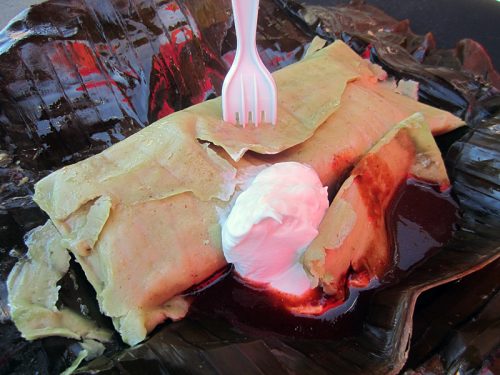
Oaxacan tamal
Location: north end/east side
For the past 15 years or so, I’ve never gone to the market without stopping at Tamal Oaxaca. I usually get the Oaxaca tamale verde ($3.50), which is chicken nestled into a tender rectangle of corn flour, steamed in a banana leaf and served with salsa verde or red mole, topped off with a scoop of crema. Though some may be scared of this big dollop of cultured cream/buttermilk, you really want it on this tamale as it provides a lush balance to the not-overly-aggressive salsa. These thick, moist tamales re-heat well in a microwave (just warm them in the banana leaf they’re served in). And if you’re planning to bring food home, consider a container of pozole (hominy in spicy broth with chunks of pork): for $6, they’ll send you home with the soup, chips, salsas and garnishes (lettuce, onion, radish).
Tacos Bernardo
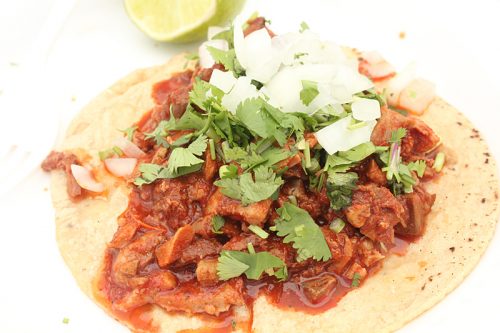
Montalayo taco at Tacos Bernardo
Location: middle/east side
As at just about every vendor at the market, the tortillas here are hand-made, fresh, very soft and absorbent, yet resilient enough to resist falling apart. During the warmer months, there are Styrofoam cups on the tables, each set with a bouquet of papalo, a mild herb and a popular condiment in Mexico. Papalo, an ancient herbal medicine, is believed by some to counteract stomach disturbances (try some; the flavor is mild and if it might help pre-empt tummy distress, what’s not to like?). If you’re feeling especially bold, consider ordering a taco of montalayo, an herbaceous and spicy red sauce mix of stomach tissue (usually from cow but sometimes from goat), as well as, perhaps, esophagus, spleen and liver (it’s a fun game: guess the organ that’s in your mouth!). A montalayo taco ($2) is only for the offal-obsessed (though it’s surprising how much the one-two-punch condiment of onion-cilantro will help almost anything go down).
Tacos Arroyos
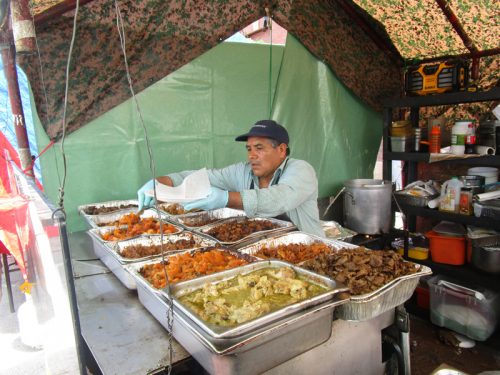 Michael Gebert
Michael Gebert Location: middle/east side
Until recently, a vendor at the market sold eyeball tacos, the quintessential bragging rights food, right up there with other atrocious comestibles like balut and bull testicles. Tacos Arroyos serves the usual array of tacos ($2), all good in their own ways, but one of those tacos comes filled with buche, pork stomach cooked in pork fat. This funky fistful of food is not going to appeal to everyone, but if you want to walk on the wild side of Maxwell Street dining, Tacos Arroyos, along with Tacos Bernard, present themselves as one of the last remaining stands to offer something a little out of the ordinary.
Xurro

Churro truck
Location: middle/west side
You’ve probably seen churros for sale in bodegas and perhaps from marginally legal street vendors in Pilsen and other Hispanic neighborhoods. They’re basically fried tubes of dough, usually sprinkled with sugar and sometimes filled with chocolate-, strawberry- or vanilla-flavored cream. There is no comparison between one of the probably days-old renditions of this simple street treat and one of these Xurro pastries that come right out of the hot oil and into your mouth. If you’re going to eat fried dough, you might as well get it fresh, still crunchy, crisp on the outside, cakey on the inside. These guys have an outlet on Navy Pier, but don’t let that turn you off: this stuff is prepared about as well as one could imagine.
Coctel de Fruta

Location: south end/east side
You can get a cocktail of fresh fruit here, and it’s fine as far as it goes, but what you really want here is mangonada. This cold Mexican sundae-type confection contains ice cream or sorbet, fresh mango, squeeze of lime, sprinkle of Tajin (chili-salt blend) and chamoy, a fruit-based sweet-sour-salty condiment, savory, much like catsup. Ingredients vary by location, but that’s the way they make it at this stand, where they also include a straw wrapped in tamarind paste. This is a huge mouthful of flavor. Variations on the mangonada are vampiros (with chunks of spicy mango) and diablitos (with tamarind syrup and hot sauce).
Guide 2: Drinking Maxwell Street
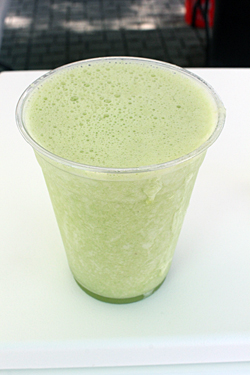
Nopales smoothie
There is no alcohol served at Maxwell Street (it’s Sunday morning, fer crissakes; what, you can’t go a few hours without getting the shakes?). However, there are some worthy fruit- and vegetable-based beverages you may want to check out:
M&J Smoothies. If you’ve never had one before, consider getting a smoothie of nopales, the cactus paddles you’ll sometimes find chopped up in tacos or on carne asada. At M&J, they take cut up nopales, celery, pineapple and orange juice, and whiz it all through a blender to create a frothy, slightly sweet and light green drink ($4). A very good complement to spicy grub. They also offer smoothies of many other fruits and vegetables, including peach, guava, spinach and beet.
El Campeon Pina Colada. For $8.50, you get a pineapple with the top cut off, scooped out and filled with canned pineapple and coconut juice. Though it looks kind of touristy (and is), it’s a refreshing beverage. Seems like a lot to carry around, but it does look fancy.
Horchata, Champurrado, Licuados. All over the market, you’ll see stands offering horchata (cinnamon-flavored rice drink), champurrado (hot chocolate atole, a corn-based drink) and licuados (watermelon, lemon and other fruit-flavored waters). Every one of these beverages goes exceptionally well with Mexican food, but if you must have a Coca-Cola, look for the Mexican ones, which use real sugar (rather than corn syrup) and have a cleaner taste (they offer Mexican Coke at Rubi’s and several other vendors around the market; it’s a little more expensive, but worth it).
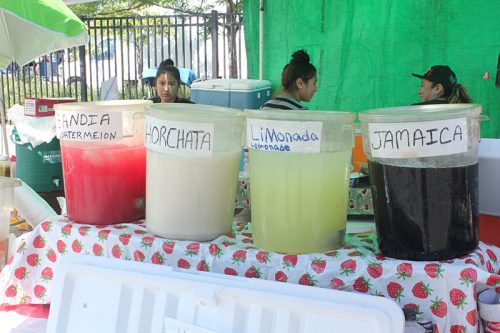
Licuados
Guide 3: Foods You’ll Find All Over the Market
There are some foods that are offered at many stands, and I list them here so that you can get them if you walk by an interesting vendor and see them advertised.
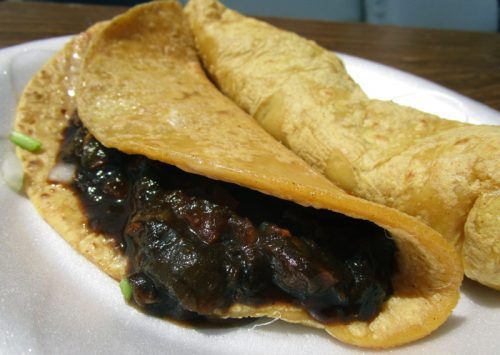 Michael Gebert
Michael Gebert Huitlacoche quesadilla (from Taqueria Flor de Mexico)
Huitlacoche. In the early Aughts, this corn fungus (or “smut,” as it is less flatteringly termed) was a rare find, exotic, absent from most Mexican restaurant menus in the city of Chicago. Now, you can have huitlacoche at a number of Maxwell Street stands, and it’s even showing up in some restaurants not owned by Rick Bayless. It’s very slightly mushroom-y, mysteriously black/purple in cast, adding lushness to any taco, though if you’re a first-timer, we suggest you have it all by itself so you can taste its subtle flavor.
Flor de Calabaza. Squash blossoms are tender and delicate, adding a not-unpleasant, complementary though slightly slimy vegetal note to a meat-forward taco. Alas, most of the flowers I’ve had at the market over the past 15 years or so have been pulled from a can, but they’re still good…and way more interesting than lettuce, though truth be told, they do not convey a huge amount of flavor.
Huarache. Traditionally, a huarache, or “slipper,” is a flat masa disk with a stuffing of beans (black beans or pinto). Do expect to get a little messy eating this open-faced tortilla sandwich: if you plan to slice through this flat, chewy disk with a knife, bring your own cutlery (the plastic stuff don’t cut it).
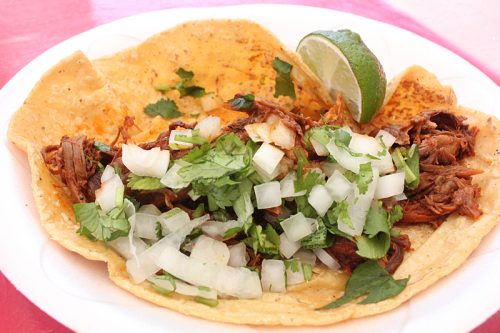
Goat (maybe) barbacoa at Taqueria Flor de Mexico
Elote. All around the market, from summer through late fall, you’re going to see ears of corn sitting on grills, waiting to be dressed with Parkay and/or mayo, lime, and chili-salt. If the corn cob is served on a stick, it’s an elote; if you have them cut off the kernels for you, what you have is called esquites, which are way more convenient to eat.
Torta Ahogada. Literally a “drowned sandwich,” a Frenchy type roll, filled with meat and covered with tomato sauce (thus, drowned). Like the huarache, it’s a total mess to eat, and you will want to be sitting down before you attack it. Grab napkins.
Birria. At Maxwell Street, the birria cooked low and slow was once mostly goat, then sometimes goat, now mostly beef. Goat seems to be one of those meats that, currently, is hard to find at the market; we had a tasty taco of what was listed as “goat barbacoa” at Taqueria Flor de Mexico, and I dunno, it was more beefy than goaty, but whatever; it’s all good. Both birria and barbacoa are tasty ways to cook inexpensive cuts of meat and maximize lusciousness.

Fashion straight outta Sinaloa
Guide 4: Cheapo Stuff
I go to Maxwell Street primarily for the ready-to-eat chow, but there’s a lot of other stuff I’ve bought there that I’ve been very happy with…and just a few items I’ve not been happy to have purchased.
Sunglasses. If you need a pair of cheap sunglasses with a little style, Maxwell Street is where you want to shop. Five bucks a pair, or sometimes two pairs for $6-10, there’s a huge selection of some wild stuff as well as more conservative Ray-Ban type sunglasses (coughknockoffcough).
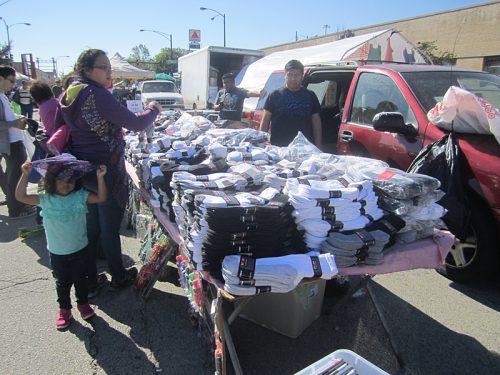
Tube sock paradise
Tube socks. I bought a pack of 10 white tube socks at the market 4 years ago for about $5. I wear them to the gym regularly; they hold up remarkably well; they were one of the best deals ever, and at the Maxwell Street Market, there’s a lot of competition among sock vendors. Take your time and comparison shop. There is no known explanation for why there are so many sellers of tube socks at the market; perhaps it’s just tradition but hey, you always need socks, right?
Fresh produce. When I was at the market in early July, I bought a case of 18 wonderfully delicious yellow mangoes for $8, a tremendous value. About 6 years ago, I bought a case of pineapples that, upon examination, proved to be rotten to the core. You have to be careful when buying produce at Maxwell Street, but more often than not, you get a great price for a pretty good product. The market is also an excellent resource for chili peppers of all types.
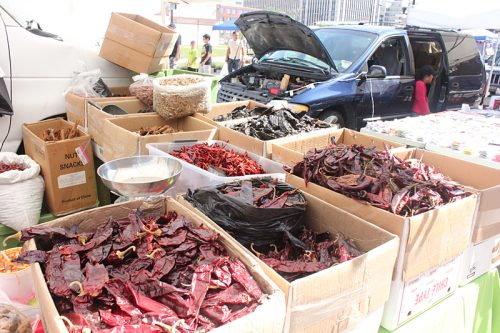
Dried chili peppers in bulk
Toiletries. There are two African-American ladies selling soap at different ends of the market, and their stuff seems to be high-quality, but be careful buying mainstream hygiene products (deodorant, shaving cream, etc.). It seems a lot of this stuff fell off a truck a long time ago, and although expiration dates are largely bullshit-by-regulation, some of these products seem not to have been stored in optimal environments, so they may have deteriorated somewhat.
Electronics. Probably not a great idea to buy an iPhone or laptop at the market, but for accessory gear (ear buds, phone cases), sure, why not, as you don’t have a lot to lose.
T Shirts. If you want to some outlandish shirts, the market is a good place to get shirts emblazoned with pictures of luchadores, the Virgin of Guadeloupe, El Chapo, and other figureheads of Hispanic culture. They’re usually pretty inexpensive, and this is the kind of stuff you can definitely bargain for. If the guy says they’re $15 (which is not an uncommon starting price), offer $10 and you may end up paying $12. It’s worked for me. Probably should have offered $8.
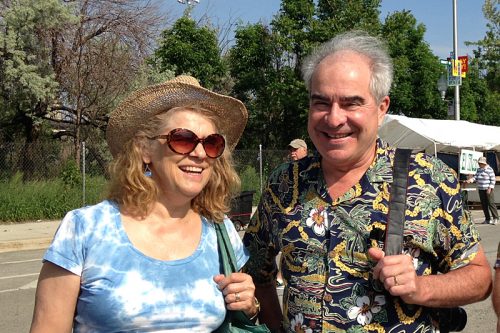 Liam Gebert
Liam Gebert David Hammond and wife Carolyn Berg at Maxwell Street
Benediction
Before going forth into the Maxwell Street Market, consider bringing sun-screen, a hat, and sunglasses—it can get pretty hot walking on that pavement in the sun.
When parking during the warmer months, get to the market early and pick a spot on the east side of a north-south street (e.g., Clinton). This way, you’ll get a little shade and come back to a car that’s not an oven.
Bring home some tortillas. I talked to the man at Flor de Mexico, and he told me he’d sell a bag of tortillas for $7. There is no better tortilla than one that’s made fresh by hand, and they’ll keep for a few days refrigerated…just make sure you warm them lightly before eating.
David Hammond is the Dining and Drinking editor for Newcity, and a current contributor to the Chicago Tribune, Plate magazine and Oak Park’s Wednesday Journal. He is a founder and moderator of LTHForum.com, wrote hundreds of reviews for the Chicago Reader, Time Out Chicago and others, wrote a weekly “Food Detective” column for the Chicago Sun-Times, and was nominated for a James Beard Foundation award for his Soundbites series for WBEZ.
Latest
Join the Discussion
After you comment, click Post. If you're not already logged in you will be asked to log in or register with Disqus.





